The New BRICS Currency Could Transform the World Economy Forever: The End of the Dollar Era!
Exploring the Potential Impact of a BRICS Currency on Global Financial Landscape
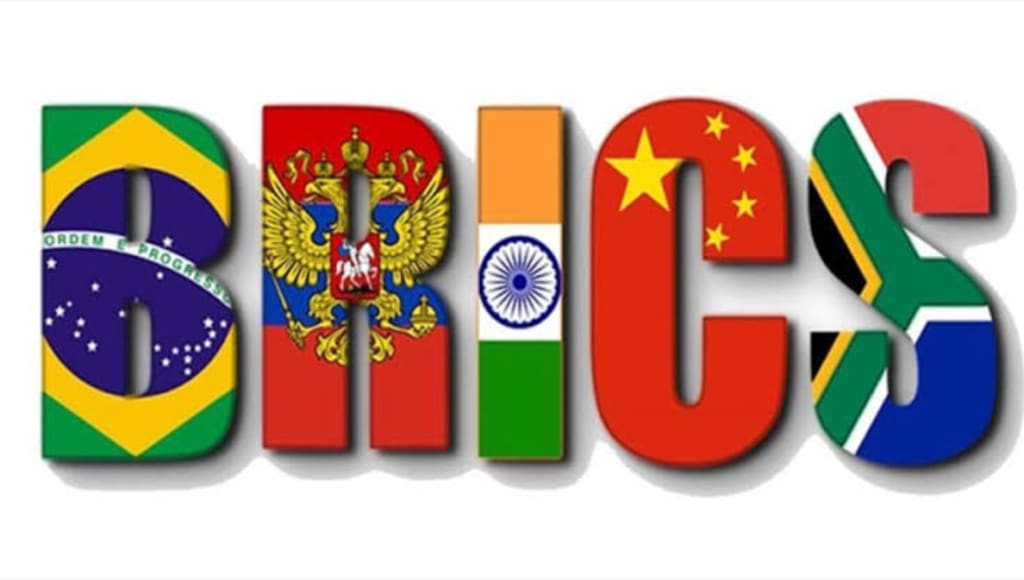
𝙎𝒊𝙣𝒄𝙚 𝙩𝒉𝙚 𝙙𝒐𝙡𝒍𝙖𝒓 𝒉𝙖𝒔 𝒃𝙚𝒆𝙣 𝙩𝒉𝙚 𝙬𝒐𝙧𝒍𝙙’𝙨 𝙢𝒂𝙞𝒏 𝒄𝙪𝒓𝙧𝒆𝙣𝒄𝙮 𝙛𝒐𝙧 𝙖 𝙡𝒐𝙣𝒈 𝒕𝙞𝒎𝙚 𝙖𝒏𝙙 𝙬𝒊𝙡𝒍 𝒍𝙞𝒌𝙚𝒍𝙮 𝙘𝒐𝙣𝒕𝙞𝒏𝙪𝒆 𝒕𝙤 𝙗𝒆 𝒔𝙤, 𝒕𝙝𝒆 𝑨𝙢𝒆𝙧𝒊𝙘𝒂𝙣 𝙚𝒄𝙤𝒏𝙤𝒎𝙮 𝙝𝒂𝙨 𝙩𝒉𝙚 𝙖𝒃𝙞𝒍𝙞𝒕𝙮 𝙩𝒐 𝒅𝙤𝒎𝙞𝒏𝙖𝒕𝙚 𝙩𝒉𝙚 𝙜𝒍𝙤𝒃𝙖𝒍 𝒆𝙘𝒐𝙣𝒐𝙢𝒚 𝒔𝙞𝒏𝙘𝒆 𝒃𝙪𝒔𝙞𝒏𝙚𝒔𝙨𝒆𝙨 𝙖𝒏𝙙 𝙞𝒏𝙫𝒆𝙨𝒕𝙤𝒓𝙨 𝙛𝒓𝙤𝒎 𝒂𝙡𝒍 𝒏𝙖𝒕𝙞𝒐𝙣𝒔 𝒑𝙧𝒆𝙛𝒆𝙧 𝙩𝒉𝙚 𝙙𝒐𝙡𝒍𝙖𝒓 𝒕𝙤 𝙖𝒏𝙮 𝙤𝒕𝙝𝒆𝙧 𝙘𝒖𝙧𝒓𝙚𝒏𝙘𝒚. 𝑯𝙤𝒘𝙚𝒗𝙚𝒓 𝒂𝙩 𝙩𝒉𝙞𝒔 𝒎𝙤𝒎𝙚𝒏𝙩 𝙤𝒕𝙝𝒆𝙧 𝙘𝒐𝙪𝒏𝙩𝒓𝙞𝒆𝙨 𝙞𝒏 𝒕𝙝𝒆 𝒘𝙤𝒓𝙡𝒅 𝒘𝙖𝒏𝙩 𝙩𝒐 𝒄𝙝𝒂𝙡𝒍𝙚𝒏𝙜𝒆 𝒕𝙝𝒊𝙨 𝙡𝒆𝙖𝒅𝙚𝒓𝙨𝒉𝙞𝒑 𝒂𝙣𝒅 𝒕𝙝𝒆 𝒎𝙖𝒊𝙣 𝙧𝒊𝙫𝒂𝙡 𝙞𝒔 𝑪𝙝𝒊𝙣𝒂, 𝒕𝙤 𝙖𝒄𝙝𝒊𝙚𝒗𝙚 𝙩𝒉𝙞𝒔 𝒕𝙝𝒆 𝑪𝙝𝒊𝙣𝒆𝙨𝒆 𝒈𝙤𝒗𝙚𝒓𝙣𝒎𝙚𝒏𝙩 𝙝𝒂𝙨 𝙛𝒐𝙧𝒎𝙚𝒅 𝒂𝙣 𝙖𝒍𝙡𝒊𝙖𝒏𝙘𝒆 𝒘𝙞𝒕𝙝 𝙤𝒕𝙝𝒆𝙧 𝙘𝒐𝙪𝒏𝙩𝒓𝙞𝒆𝙨 𝙖𝒏𝙙 𝙩𝒉𝙚𝒚 𝒂𝙞𝒎 𝒕𝙤 𝙘𝒓𝙚𝒂𝙩𝒆 𝒂 𝒄𝙪𝒓𝙧𝒆𝙣𝒄𝙮 𝙩𝒉𝙖𝒕 𝒊𝙨 𝙨𝒐 𝒑𝙤𝒘𝙚𝒓𝙛𝒖𝙡 𝙩𝒉𝙖𝒕 𝒊𝙩 𝙘𝒐𝙪𝒍𝙙 𝘿𝒆𝙩𝒉𝙧𝒐𝙣𝒆 𝒕𝙝𝒆 𝒅𝙤𝒍𝙡𝒂𝙧 𝙖𝒔 𝒕𝙝𝒆 𝒘𝙤𝒓𝙡𝒅’𝒔 𝒑𝙧𝒊𝙢𝒂𝙧𝒚 𝒄𝙪𝒓𝙧𝒆𝙣𝒄𝙮.
In this article, we will examine the goals of this Alliance and the potential effects of its new currency. When the majority of nations in the globe ratified the Bretton Woods agreement in 1944, the American dollar replaced the British pound as the dominant currency after globe War II. By virtue of this arrangement, the dollar became the reserve currency. What is a reserve currency, and why is it crucial for governments and individuals to have one? governments and individuals save money and put it in their banks, which they refer to as the savings reserve. They can choose to hold it in a currency like the dollar or the euro, or in precious metals like gold or silver.
This Reserve is crucial because, among other things, it strengthens the nation’s own currency. For example, if a nation prints $100 billion worth of its own money, it must buy an amount equal to that amount in gold or dollars to prevent its currency from depreciating. In this way, each printed note would have a dollar guarantee, making the currency dependable after World War II.
The reason the dollar was chosen as the world’s reserve currency was because for every dollar printed, there was an equivalent amount of gold kept in the Federal Reserve Reserves, which is the Central Bank of the United States. Because it was the most trustworthy currency available, the dollar rose to become the most used currency in international trade.
Due to the decision made on August 15, 1971, by then-President Richard Nixon, the United States no longer has all of its currency backed by gold as it did in the years following World War II. At the time, the country was going through an economic crisis, and the Nixon Administration needed to print money to give to banks so they could lend it to people so they could spend more money in business.
The United States has the largest economy in the world and a very strong democracy, which makes it less likely for a dictator to seize power. As a result, the dollar has continued to be the strongest currency in the world despite the system of backing dollars with gold. The most used currency in international trade as well as the Reserve currency.
Despite recent declines, nearly 60% of the world’s reserves are held in dollars today. However, a group of nations is threatening to depose the United States as global leader and wants to introduce its own currency to compete with the dollar. What are these nations prepared to offer in competition with the US, and what is this new currency?
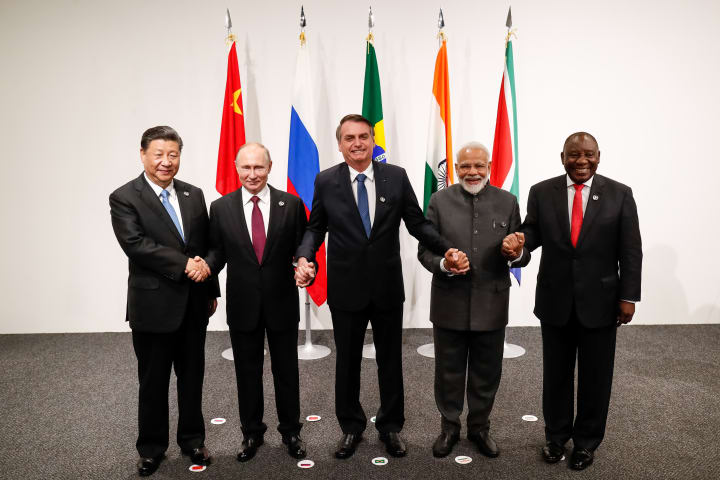
Well, they are from Brazil. Russia and India Recently, the BRICS nations – Brazil, Russia, India, China, and South Africa – an acronym made from the first letters of each member nation – announced that they are developing a new currency. The goal of this currency is to eliminate the need for these nations to maintain reserves of dollars and other Western currencies like the Euro or the British pound. If a nation holds its reserves in dollars and the value of the dollar declines owing to inflation, the reserves of that nation will likewise decline in value.
However, since the dollar is used by all nations and the US economy is the biggest in the world, there are other issues as well. In addition, investors still view the dollar as the strongest currency currently, which means that when the world faces a crisis, they decide to sell all of their investments, including stocks, and convert all of their money into dollars, which causes the dollar to depreciate.
The dollar still stands. The chosen currency for investors to protect the value of their money at the end of 2021 Global stock markets started to decline as investors noticed that US inflation was beginning to rise and that this could lead to a crisis in the nation. Additionally, in early 2022, the war between Russia and Ukraine broke out, which increased investor fear. As a result, investors from all over the world started to sell their investments and seek safety in the dollar.
Investors began converting local currencies, including the Euro, into dollars for this purpose, which led to the dollar’s appreciation versus the majority of international currencies. The brics countries believe that leaving the dollar would help them lessen the impact of global economic crises because if they can have a currency stronger than the dollar their currency would not be affected by it. This graph illustrates the dollar index, which measures the strength of the dollar against all other world currencies. Between late 2021 and may 2022 the dollar index begins to soar, indicating that the value of all other currencies has declined.
Additionally, it would aid them in reducing the effects of American inflation, which might increase the stability of the value of their reserves. Additionally, the brics countries’ adoption of their own currency would not only have a significant economic impact because it would be the strongest in the world, but it would also improve trade relations between the nations by allowing them to conduct business without depending on the dollar.
However, several of the BRICS nations are already striving to lessen their reliance on the dollar and progressively weaken the value of this currency in addition to the Joint Currency Creation Project.
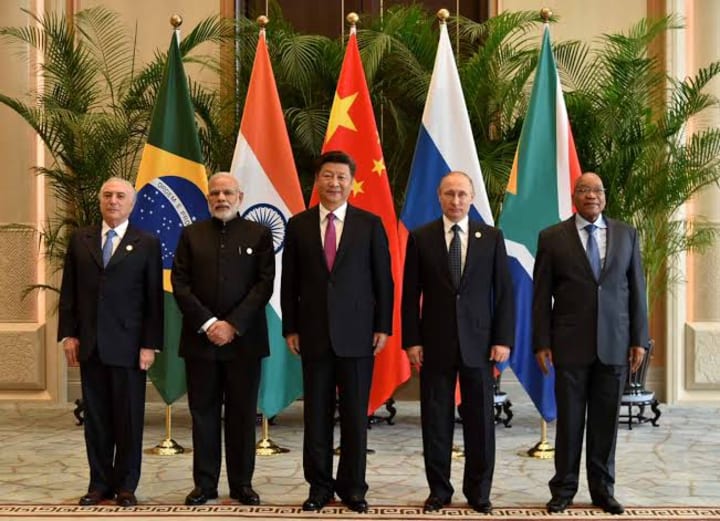
China and Brazil inked a trade pact last month to stop using the dollar. As a result of this agreement, they will no longer need to trade in dollars but will instead do it in their own national currencies. Chinese businesspeople will pay Brazilian businesspeople in Yuan, while Brazilian businesspeople will pay Chinese businesspeople in race.
This agreement is not the only one that China has made, as it is a part of a long-term strategy by the Chinese government to make the Yuan the dominant currency in the world. Saudi Arabia, for instance, began talks with China in 2022 on a deal to accept Yuan in place of dollars for the sale of oil barrels. Additionally, Russia has been looking for alternatives to the dollar. Recently, Russia and Iran began researching the development of a digital currency for international trade, also referred to as a central bank digital currency. The cryptocurrency known as bitcoin cash (cbdc) is a form of payment that is entirely digital rather than written on paper like all other currencies. It is developed on the blockchain, a network resembling the internet.
In addition, when the conflict between Russia and Ukraine broke out, Russia announced it would use the Chinese Yuan as one of its reserve currencies, and as of today, 20 of the Russian central banks reserves are held in Yuan, which is another indication that China and Russia are attempting to move away from the use of the dollar, according to a Bloomberg report.
However, returning to the BRICS nations, how may their new currency differ from the US dollar? There is currently a barrier preventing the brics nations from creating their own currency, and this is that they lack a formal trade agreement that would permit them to do so. This is true even though they have agreed to work toward achieving such an agreement, there is still no written document that all countries have signed. In order for multiple countries to share a common currency, an agreement must be signed by all of the countries with the intention of doing so. The Eurozone is the prime illustration of this. The nations that make up the Eurozone, including Spain, Germany, France, and others, agreed to establish the currency known as the Euro, but it did not materialize immediately.
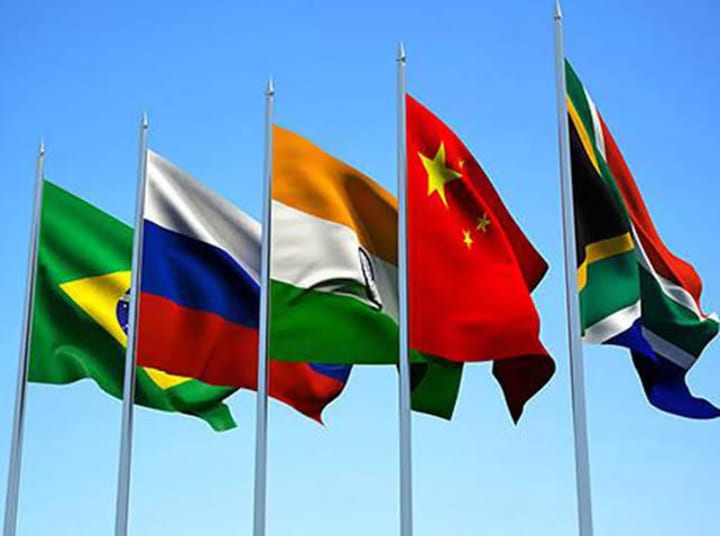
The agreement that established the Euro was signed in December 1991, but it wasn’t until 2002 that the notes and coins that countries use today were put into circulation, so the question is, if this currency is created among the BRICS countries, what utility would it have today? It will probably be used only in very large transactions initially, like between governments like a loan that one Country grants to another, but if these countries eventually managed to have their own currencies, what utility would it have today?
Since the U.S. dollar is used in nearly 90% of all international transactions, the United States currently generates 24 percent of the world’s gross domestic product (GDP), or the total amount of money a country spends on goods and services. If the brics nations united, however, their GDP would already be equal to that of the United States, with Brazil at 2.1%, Russia at 1.94%, India at 1.8% and South Africa at 0.4% totaling just over 24 percent.
How much could this currency influence the strength of the American dollar and how might it affect the average person? To see the potential impact, let’s look at the case of the Euro, which has been in use by many European nations for over 20 years. When the Euro was first introduced, it wasn’t thought to be a serious competitor to the dollar, but reality showed that while it didn’t completely replace it, it did lessen the dollar’s dominance.
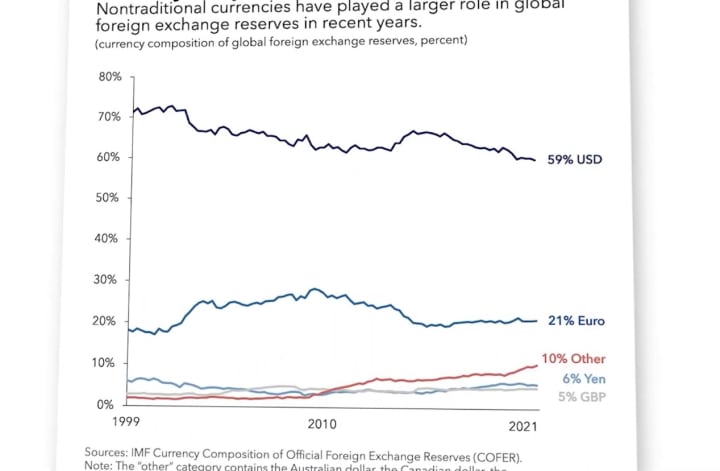
This graph displays the percentage of the world’s reserves kept in various currencies. The dollar is represented by the dark blue line, while the euro is represented by the light blue line. All trade between European nations and certain nations outside the Eurozone was conducted in the Euro. However, the combined GDP of the Eurozone countries has never surpassed China’s GDP in recent years, which is the reason the Euro has not been able to overtake the dollar.
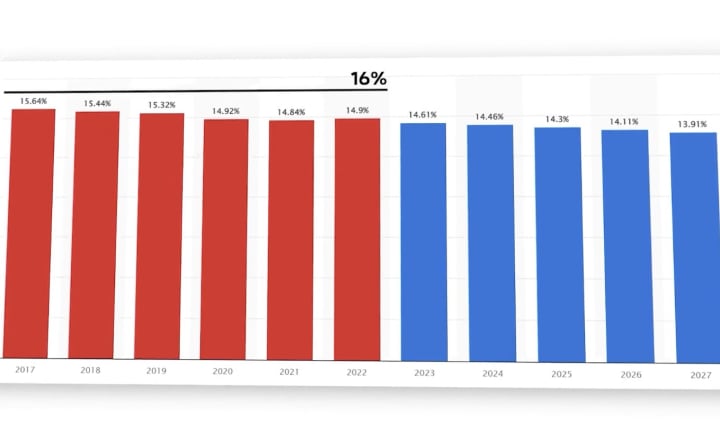
This graph shows the share of Europe’s GDP in the global GDP, which did not exceed 16 between 2017 and 2022 and estimates indicate that this percentage would continue to decline in the coming years. However, if the BRICS countries signed a formal alliance agreement similar to the European Union, things would be different because their combined GDP, primarily thanks to China, would be equal to that of the United States in terms of its impact on individuals.
The local currencies of these nations’ citizens would have to be exchanged for the new ones, and businesses would have to adjust their prices to reflect the new currencies. Additionally, since there would be no need to convert currencies, traveling between these nations would be much simpler. Since there would be no currency exchange required for the conversion to dollars or any other currency, even moving money between enterprises located in different nations would be simpler.
Although China continues to pursue their plans to challenge the dollar’s supremacy, the creation of a joint currency would take many years because the nations would need to negotiate the agreement, sign it, and then start planning the implementation of their own currency. As we saw with the Euro, this process can take a long time. The digital Yuan is one of the ways China wants to weaken the dollar’s position as the world’s reserve currency. Over 114 countries worldwide are looking into implementing digital currencies, with 60 of them already in advanced phases of study.
Due to the need for laws to regulate its operation, which have not yet been approved, as well as each country testing its own digital currencies, Russia’s plans to test its own digital currency, the digital Ruble, on April 1st 2023 have been indefinitely postponed.
The aim is for the brics countries to share a single currency given the time it takes for each to develop its own. China may try to do this by attempting to make the digital yuan, which has already been released, the common currency among the brics countries. The introduction of the digital Yuan is thought to be a means by which China will make the Yuan more powerful than the US dollar, but aside from this supposition, it is unknown which currency will serve as the common unit of account for the BRICS. It could be the Chinese Yuan, the Russian Ruble, the Indian rupee, or a brand-new currency.
There aren’t many nations strong enough to have currencies that could replace the dollar at the moment, but based on statements from some influential authorities in the brics countries, it seems clear that it will be a digital currency rather than a traditional one. Are other nations considering doing the same? Could other nations in the world join the brics Nations?
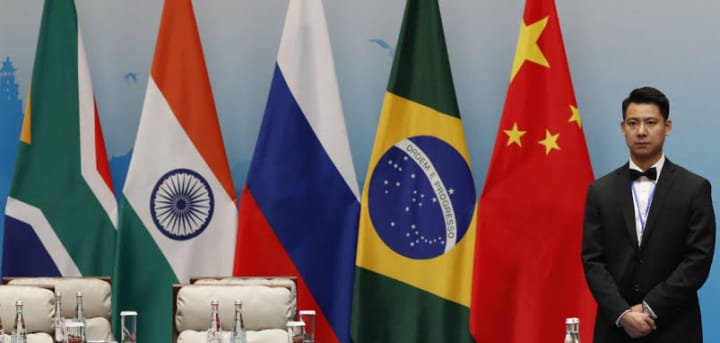
The dollar is now the most extensively used currency in the world, so if the BRICS countries are successful in creating their own currency, it’s likely that more nations may want to join. However, doing away with the dollar could make international trade more difficult.
For instance, if a country decides to replace the dollar with the brics currency, it may have trouble finding other nations to trade with. If, on the other hand, a country needs to buy a specific product that is only produced by American producers, and that country has replaced all of its reserves with the brics currency, it would be powerless to negotiate with the United States. There is undoubtedly an economic conflict between the United States and the BRICS.
China is still looking for partners and agreements that will allow it to oppose this leadership, which is why. The brics seem to be what China needs to overthrow the dollar’s dominance, but the time it will take for them to create their own currency may not be what China wants.
𝑾𝙝𝒐 𝒅𝙤 𝙮𝒐𝙪 𝙗𝒆𝙡𝒊𝙚𝒗𝙚 𝙬𝒊𝙡𝒍 𝒑𝙧𝒆𝙫𝒂𝙞𝒍 𝒊𝙣 𝙩𝒉𝙞𝒔 𝒄𝙤𝒏𝙛𝒍𝙞𝒄𝙩?
(𝘾𝒐𝙢𝒎𝙚𝒏𝙩 𝙝𝒆𝙧𝒆 𝒘𝙞𝒕𝙝 𝙮𝒐𝙪𝒓 𝒕𝙝𝒐𝙪𝒈𝙝𝒕𝙨 𝙤𝒏 𝒕𝙝𝒆 𝑩𝙍𝑰𝘾𝑺 𝒂𝙣𝒅 𝒑𝙧𝒆𝙙𝒊𝙘𝒕𝙞𝒐𝙣𝒔 𝒇𝙤𝒓 𝒕𝙝𝒆 𝒇𝙪𝒕𝙪𝒓𝙚?)
About the Creator
Enjoyed the story? Support the Creator.
Subscribe for free to receive all their stories in your feed. You could also pledge your support or give them a one-off tip, letting them know you appreciate their work.





Comments
There are no comments for this story
Be the first to respond and start the conversation.